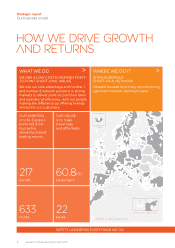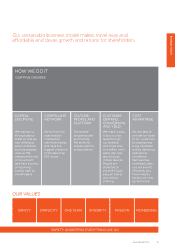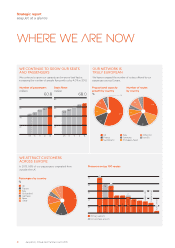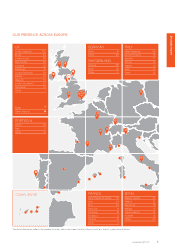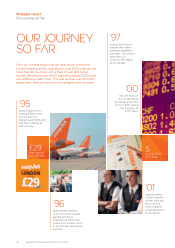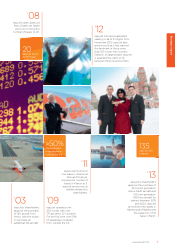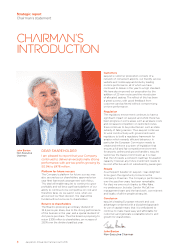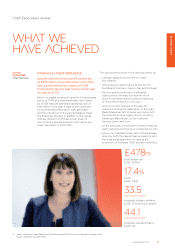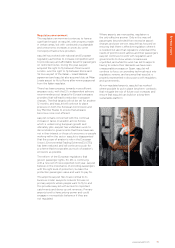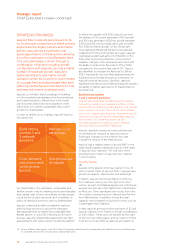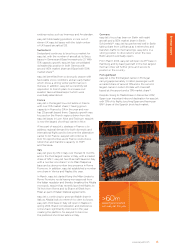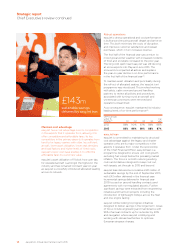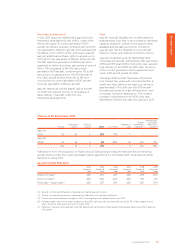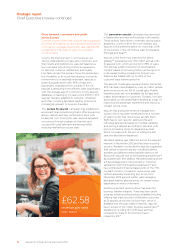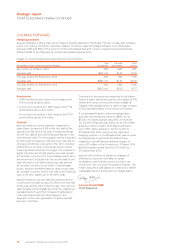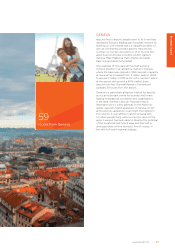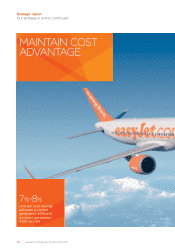EasyJet 2013 Annual Report Download - page 14
Download and view the complete annual report
Please find page 14 of the 2013 EasyJet annual report below. You can navigate through the pages in the report by either clicking on the pages listed below, or by using the keyword search tool below to find specific information within the annual report.
12 easyJet plc Annual report and accounts 2013
Strategic report
Chief Executive’s review continued
STRATEGIC PROGRESS
easyJet flies to airports people want to fly
to; its principal competitors at these primary
airports are the legacy carriers and charter
airlines. easyJet has a significant cost
advantage relative to these airlines allowing
it to offer customers more affordable fares.
This cost advantage is driven through a
combination of factors including aircraft
configuration with easyJet carrying a higher
number of seats per aircraft; easyJet’s
higher load factors and higher aircraft
utilisation driven by its point-to-point model;
its younger fleet and advantaged fleet deal
reducing ownership and maintenance costs
and easyJet’s leaner overhead costs.
easyJet is confident that its strategy of building
on its competitive advantages of a strong network
and market positions, efficient low-cost model,
pan-European brand and strong balance sheet
will position it to deliver sustainable returns and
growth for shareholders.
In order to deliver on its strategy, easyJet has four
key objectives:
For shareholders, this will deliver: sustainable and
flexible growth; industry leading returns and tangible
and regular cash returns via ordinary dividends paid
out at a third of post-tax profit; and, in addition, a
policy of distributing excess cash to shareholders.
easyJet undertook a highly competitive, rigorous
and thorough process to secure the necessary
fleet arrangements to deliver this sustainable and
flexible growth. In July 2013, following an 18 month
process, easyJet’s shareholders approved new fleet
arrangements with Airbus which provide the platform
to deliver this growth until 2022. easyJet secured
the delivery of 35 current generation A320 aircraft
and 100 new generation A320neo aircraft between
2015 and 2022 with purchase rights over a further
100 A320neo family aircraft. Of the 135 aircraft
to be delivered, 85 aircraft will be for the planned
replacement of the existing fleet as it ages. easyJet
negotiated a significant amount of flexibility in the
fleet order to provide protection in the event of
negative changes in the external environment with
the ability to reduce the fleet size to 171 by 2022
compared to the current fleet size of 217. There is
also flexibility to increase the fleet size to 298 by
2022. Importantly, the new fleet arrangements are
expected to be funded through a combination of
easyJet’s internal resources, cashflow, sale and
leaseback transactions and debt and easyJet expects
the ability to deliver cash returns to shareholders to
be enhanced.
Build strong number
1 and 2 network positions
easyJet has developed the leading pan-European
network by building up a valuable portfolio of slots,
held at slot constrained, primary airports over several
years. easyJet connects more of the top European
city-to-city market pairs than any other airline and its
network is a clear competitive advantage. easyJet
has number 1 or 2 market positions at slot
constrained airports including London Gatwick,
Geneva, Paris Orly and Milan Malpensa.
easyJet regularly reviews its route portfolio and
re-orientates its network to optimise returns.
Significant changes to the network this year
include the closure of the Madrid base.
easyJet has a market share of around 8%(2) in the
total intra-European market and around 31% share
in easyJet’s key markets.(2) An overview of the
developments in each of easyJet’s key markets
is shown below.
Country review
UK
easyJet is the largest short-haul carrier in the UK
with a market share of around 20%.(2) easyJet saw
growth at Gatwick, Manchester and Edinburgh.
In March, easyJet introduced flights to Moscow
from Gatwick, having won the right to fly from
London as part of a bilateral agreement with Russia.
easyJet has also launched flights from Manchester
to Moscow. Other significant new routes from the
UK include Luxembourg from Gatwick and Tel Aviv
from Manchester. In addition during the year
capacity was increased on business routes such as
Copenhagen from Gatwick.
In May, easyJet announced the purchase of 25 slot
pairs at Gatwick from Flybe for a total consideration
of £20 million. These slots will transfer at the start
of the summer 2014 season and be used to further
build the route portfolio at Gatwick and depth on
Build strong
number 1 and
2 network
positions
Drive demand,
conversion and
yields across
Europe
Maintain cost
advantage
Disciplined use
of capital
(2) Source: Market share figures from OAG. Size of European market based on internal easyJet definition. Historical data based
on 12 month period from October 2012 to September 2013.


